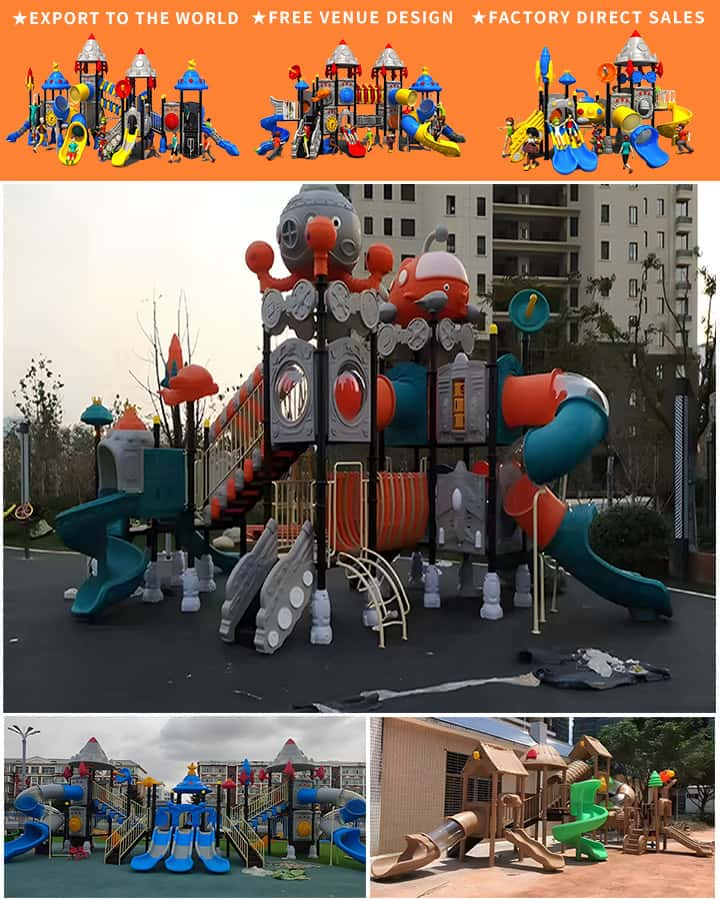Outdoor playgrounds are a treasure trove of excitement for children, offering a variety of activities that foster physical health, social skills, and imaginative play. From climbing to sliding, swinging to spinning, each piece of equipment provides unique benefits and endless fun. Let’s delve into some of the most popular outdoor playground equipment names and their roles in developing young minds and bodies.
Slides
Slides are perhaps the quintessential piece of playground equipment, beloved for their simple joy of descending from a height. Whether made of metal, plastic, or fiberglass, slides come in various shapes and sizes including straight, spiral, and tube varieties. They help develop children’s coordination and sense of orientation.
Swings
Swings are another staple of playgrounds and are excellent for building balance and core strength. Traditional swings, tire swings, and even adaptive swings offer different experiences. The motion of swinging helps children with vestibular development, which is crucial for spatial awareness.
Jungle Gyms
Jungle gyms, also known as climbers or play structures, are multi-functional setups that include ladders, bridges, and tunnels. These structures encourage physical fitness through climbing and traversing. They also promote problem-solving skills as children navigate the various obstacles.

See-Saws and Teeter-Totters
See-saws or teeter-totters have been delighting children for generations. This classic piece of equipment teaches balance and cooperation when two children play together. It’s not just about fun; it also enhances social interaction and turn-taking.
Merry-Go-Rounds
Merry-go-rounds add an element of whimsy to any playground. Children can spin themselves around by pushing off the ground or use hand cranks. This equipment improves motor skills and introduces children to the concept of centrifugal force, all while being incredibly entertaining.
Sandboxes
Sandboxes provide a tactile and creative outlet for children. Digging, building sandcastles, and exploring textures in a sandbox engage fine motor skills and stimulate imagination. Many modern sandboxes include covers to keep the sand clean and accessible shade structures to protect kids from the sun.
Climbing Walls
Climbing walls come in vertical or inclined designs and are great for building upper body strength and coordination. Some are free-standing, while others are integrated into larger play structures. These walls offer a controlled environment for children to challenge themselves physically.
Spring Riders
Spring riders, often themed as animals, provide a bouncy experience that children find irresistible. These ride-on toys use spring mechanisms to simulate the gait of horses or other creatures, aiding in gross motor development and giving children a thrilling ride.
Playhouses
Playhouses are miniature models of houses and can be as simple or elaborate as desired. They encourage imaginative play and role-playing, helping children develop social skills and cognitive abilities. Many playgrounds incorporate playhouses as part of larger structures like jungle gyms.
Zig-Zags and Balance Beams
Zig-zag paths and balance beams are fantastic for improving balance and coordination. These narrow pathways require focus and control, challenging children to steady themselves as they walk along them. They’re perfect for developing confidence in physical abilities.
In conclusion, outdoor playground equipment offers much more than just amusement; it plays a critical role in the holistic development of children. Each piece of equipment serves a unique purpose, contributing to physical fitness, cognitive growth, and social interaction. So next time you visit a playground, take a moment to appreciate the array of equipment and the myriad ways they help shape young lives




